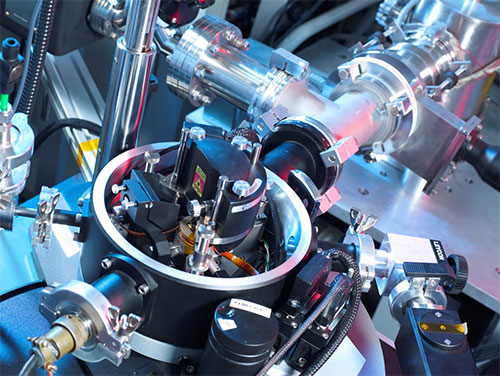 Our environmental scanning probe microscope is designed for probing continuous thin-films and patterned devices with nanometre resolution, including imaging of clusters of atomic defects. As a complementary technique, simultaneous (magneto)transport measurements can be performed on patterned devices, which allows for correlation of local work-function values with electronic properties on the micro-scale. In the case of un-patterned uniform samples, a permanent magnet can be used to measure magneto-transport properties in the van der Pauw geometry.
Our environmental scanning probe microscope is designed for probing continuous thin-films and patterned devices with nanometre resolution, including imaging of clusters of atomic defects. As a complementary technique, simultaneous (magneto)transport measurements can be performed on patterned devices, which allows for correlation of local work-function values with electronic properties on the micro-scale. In the case of un-patterned uniform samples, a permanent magnet can be used to measure magneto-transport properties in the van der Pauw geometry.
Measurements of intrinsic electronic properties of a material are carried out in vacuum or well controlled environments so they are not affected by environmental adsorbates and contamination. The technique allows visualisation of areas with different doping amounts or type and of different number of layers in 2D materials or defect structures. This technique allows accurate monitoring of environmental effects, restoration of intrinsic properties by mild vacuum annealing and measurements for long time stability and reproducibility
Our system is based on a custom-modified NT-MDT Aura SPM system. By operating in frequency or amplitude modulated Kelvin probe force microscopy (KPFM), simultaneous topographic and electrical characterisation is performed, with nanometre resolution below ~50 nm and 10 mV, respectively. Local work-function maps can be also obtained providing quantifiable insights on the electrical properties of the sample. The environmental system can perform measurements in ambient, vacuum (up to 10-6 mbar), and highly controlled (humidity, gas atmosphere, temperature) environment. The latter includes a combination of gases at variable concentrations as low as tens of parts-per-billion using mass flow controllers, as for example nitrogen dioxide (NO2), or under different levels of relative humidity from 0-90%.
Frontiers of graphene and 2D material-based gas sensors for environmental monitoring
Contactless measurements of graphene charge density variation in a controlled humidity environment